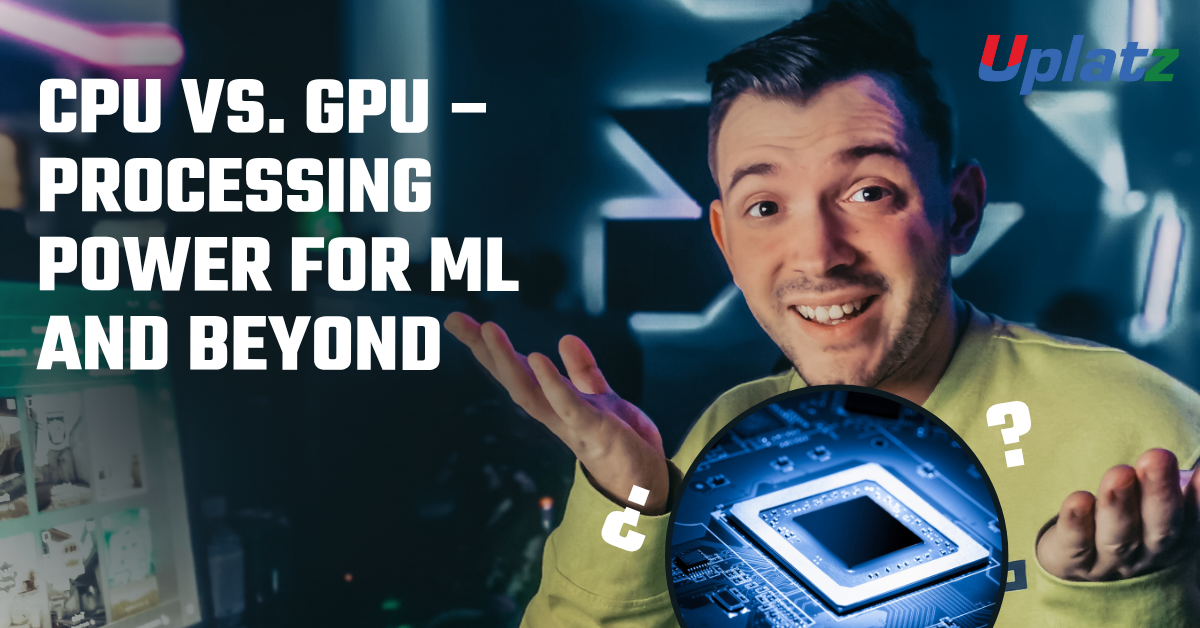CPU vs. GPU – Processing Power for ML and Beyond
In modern computing, central processing units (CPUs) and graphics processing units (GPUs) serve distinct roles based on their architectures, capabilities, and design goals. While CPUs excel at general-purpose, sequential tasks with complex control logic, GPUs shine at massively parallel workloads such as machine learning (ML) and high-performance computing (HPC). The following sections compare these processors across architecture, performance, use cases, and operational considerations.

- Architectural Overview
1.1 CPU Architecture
A CPU comprises a few powerful cores with deep instruction pipelines, sophisticated branch prediction, and large caches (L1, L2, L3) to optimize sequential task execution and low-latency response. Each core supports multi-threading (e.g., Intel Hyper-Threading), enabling it to handle multiple instruction streams concurrently while orchestrating I/O, operating system services, and control-intensive computations.
1.2 GPU Architecture
GPUs consist of hundreds to thousands of simpler cores organized into streaming multiprocessors (SMs) that execute the same instruction across many data elements in parallel (SIMD/SIMT) . Modern GPUs include specialized Tensor Cores for matrix operations, delivering mixed-precision acceleration critical for deep learning training and inference. High-bandwidth memory (HBM3) provides up to 4.8 TB/s throughput, minimizing data transfer bottlenecks for large models and datasets.
- Performance Characteristics
2.1 Parallel Throughput
GPUs leverage thousands of cores to achieve massively parallel execution, accelerating tasks like neural network training by breaking workloads into thousands of threads processed simultaneously. Training deep models on top-tier GPUs can be over ten times faster than on equivalent-cost CPU systems, thanks to parallelism and Tensor Core optimizations.
2.2 Sequential and Latency-Sensitive Tasks
CPUs are optimized for branch-heavy code and low-latency execution of sequential tasks. Their deep caches and branch predictors reduce instruction stalls, making them ideal for control-flow intensive workloads and smaller ML models or inference scenarios that require rapid per-request response.
2.3 Memory Bandwidth
Typical modern CPUs offer memory bandwidth around 50 GB/s, whereas GPUs reach several terabytes per second (e.g., 7.8 TB/s on leading cards), a vital factor for data-intensive ML workloads that stream large tensors during training and evaluation.
- Use Cases in Machine Learning
3.1 Model Training
Large-scale neural network training demands high throughput for matrix multiplications and convolution operations. GPUs with thousands of cores and Tensor Cores reduce epoch times dramatically, especially for deep learning and reinforcement learning tasks.
3.2 Inference and Deployment
While GPUs excel at batch inference with high parallelism, CPUs often serve cost-sensitive inference for smaller models or real-time applications requiring low latency and modest throughput
3.3 Data Preprocessing and Pipelines
Data ingestion, augmentation, and preprocessing often involve diverse operations and branching logic. CPUs manage these stages effectively before offloading compute-heavy kernels to GPUs.
-
Operational Considerations
4.1 Power Efficiency
GPUs yield better energy efficiency per operation for parallel workloads, reducing total training energy compared to CPU-only systems, though absolute TDPs are higher (e.g., 250 W vs. 95 W for comparable CPUs).
4.2 Cost
High-end GPUs can cost upwards of $20,000 per card, while server CPUs range from $2,000–$5,000. Total cost of ownership must weigh accelerated time-to-result and energy savings against hardware and data-center expenses.
4.3 Ecosystem and Tooling
Rich software ecosystems (CUDA, cuDNN, TensorRT) simplify GPU programming for ML. CPUs benefit from mature compilers, multithreading (OpenMP, TBB), and broad support for enterprise applications
- Summary Comparison
| Aspect | CPU | GPU |
| Core Count | 4–64 powerful cores | Hundreds–thousands of simpler cores |
| Clock Speed | 2–4 GHz | 1–2 GHz |
| Memory Bandwidth | ~50 GB/s | 1–8 TB/s (HBM3) |
| Best For | Sequential, branching, low-latency | Data parallel, high-throughput ML/HPC |
| Energy Efficiency | Good at low utilization | Optimal for sustained parallel workloads |
| Cost | $500–$5,000 per socket | $1,000–$25,000 per card |
- Conclusion
The choice between CPUs and GPUs hinges on workload characteristics. For general-purpose computing, real-time control, and smaller ML models, CPUs remain indispensable. Conversely, GPUs deliver transformative acceleration for large-scale ML training, deep learning, and HPC tasks through massive parallelism and specialized cores. Hybrid architectures that combine CPUs for orchestration and GPUs for compute-intensive kernels offer the most balanced, cost-effective solution in modern AI and data-driven environments.
